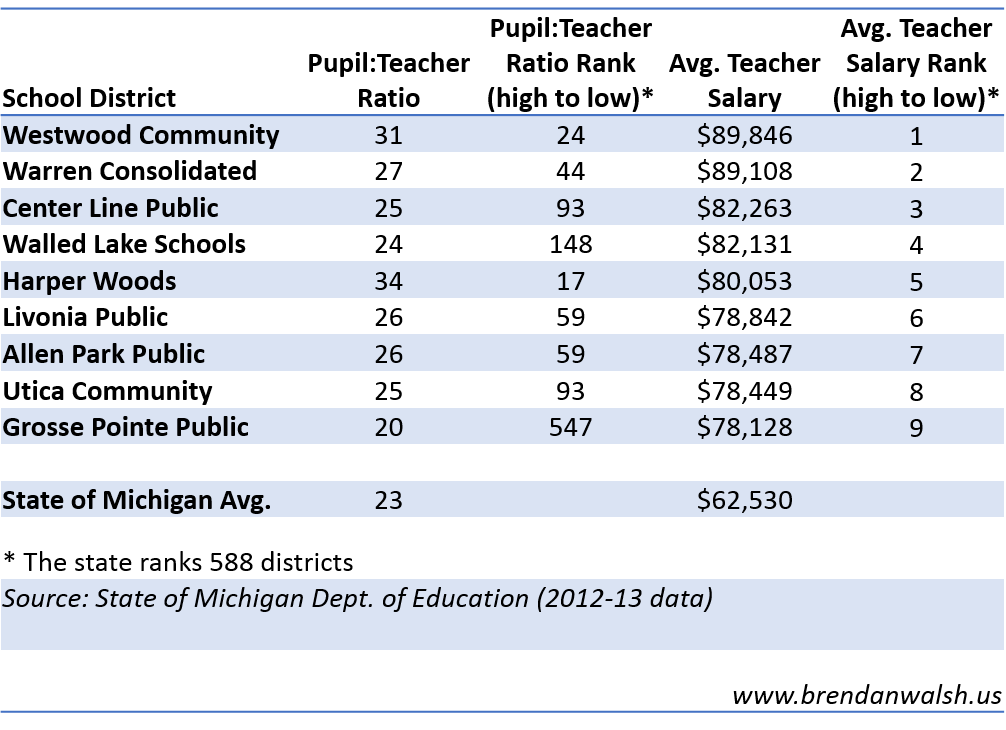A school board candidate expressed concern about employee morale in relation to the teacher contracts. We must deal in facts when such matters are discussed. As I always do when I discuss teacher compensation, I remind that discussing it is not the same as complaining about it or saying that teachers are overpaid.
I do say our teachers are paid very well for the great work they do and have working conditions extremely rare when compared to their peers across the state. For those who worry that our compensation systems are a detriment to getting the best talent, I suggest you look at facts and realize our compensation plan and working conditions should be our competitive advantage to getting and retaining the best teachers. The numbers bear this out.
The first chart below shows where the GPPSS teachers sat on a curve of the 588 districts ranked by the state. I indicate GPPSS position with the red dot.
Of those 588 districts in 2012-13, the GPPSS was ranked 9th highest in the state. The chart below shows the districts that pay their teachers, on average, more than the GPPSS. It also shows the ratio of general education students to general education teachers for those same districts. The lower the ratio the more teachers the district employs in proportion to students. The state ranking is listed as well, ranging from a high ranking (fewer teachers) to low ranking (more teachers).
Only 41 districts had a lower ratio of students to teachers than the GPPSS – and none of them paid their teachers as well as the GPPSS does. The lower ratio usually means smaller class sizes and more course offerings (e.g. 7 period versus 6 period day).
Now let’s look at the effect on the district in two ways. How many fewer teachers would we employ if we (a) paid the same average salary as the cross referenced district, or (b) had the same higher ratio of pupils to teachers as the cross referenced district? The chart below shows that for all the school district whose teacher average pay is higher than the GPPSS. As a point of reference, in 2012-13, the GPPSS employed 424 general education teachers.
The third chart shows you how hard it is to compensate teachers very well AND keep class sizes down and course offerings up. Meanwhile in the bigger financial picture, we’ll be able to do so while running annual budget surpluses and return fund equity to 10% by 2016-17.
The data here is for 2012-13 so many will wonder what happens to our rankings given the 4.9% reduction in 2013-14 and the on-schedule salary increases of 2015-16 and 2016-17 (1% and 1.8% respectively). After all that, if no GPPSS teachers progressed on step and lane increases (an impossibility) the GPPSS average salary would rank 15th of the 588 in Michigan. Of course it will be higher than that.
The 70 or so new teachers that were hired in 2010 as a result of the Early Retirement Incentive started in 2010-11 at a base salary of about $39,000. The current salary schedule will pay those same teachers at least $50,419 in 2016-17 if they still have just a bachelors degree. If they have obtained a Masters degree by then, they will earn $59,205, a nearly 50% salary increase. Our salary schedule allows teachers to progress their compensation quickly. Contrary to the belief of some, the new contracts did not punish our younger teachers.
As for non-teaching staff compensation, or as to why we no longer offer unlimited sick days, these are the upshot of the compensation plans we offer teachers. The budget contraction period from 2008 through 2012 proved that.
The process to get the district to budget equilibrium was brutal and I can understand why employees may be scarred. But we have to maintain perspective. We do pay teachers very well and will continue to do so. The alternatives were far worse.



2 responses to “Keep perspective on GPPSS teacher compensation”
Thank you for providing this information.
[…] Budget approval season is upon us for Michigan public schools and at least two – Farmington and Southfield – are learning how hard it is to maintain low class sizes, robust course offerings and pay higher than average teacher salaries – a topic I have treated before. […]